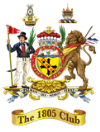Andover
The county town of Hampshire, Andover is on the River Anton and dates back to Saxon times. One of the chief industries in the town for a long time was wool processing, something that is reflected in street names such as “Sheep Fair”. The town boasts a Norman arch dating from around 1150 which is all that remains of the ancient Old Church of St Mary.
During the 18th and 19th centuries Andover became a refuelling and overnight stop for stagecoaches and other passing trade. Most of the towns buildings were erected during this period. A plaque celebrating Lieutenant Lapenotiere’s stop here to change the horses can be seen on the west wall of the Guildhall.
The town has a street market every Thursday and Saturday in the High Street. The annual Andover Shilling Fair celebrates the towns Georgian heritage and The Trafalgar Way attended in 2018 and 2019 with their Lieutenant Lapenotiere in uniform. He re-told his 1805 adventure for the town’s children.
The Andover Workhouse scandal of the 1840’s revealed serious defects in the administration of the English ‘New Poor Law’. The scandal broke when it was revealed that inmates were so hungry they were fighting over bones that they were crushing to make fertiliser. The workhouse can still be seen on Junction Road and is now a luxury residential development called The Cloisters.
Return to overview

Whitchurch, a street which hasn't changed a great deal since Lapenotiere travelled through.
Whitchurch looking timeless in the sunshine. Image © Kathy Brown/The 1805 Club
Andover Down, Hurstbourne Priors, Whitchurch,
From Andover The Trafalgar Way heads almost due East on the B3400 through the hamlet of Andover Down and then the village of Hurstbourne Priors whose 12th century parish church of St Andrew the Apostle is the oldest in the Diocese of Winchester. The second largest horse chestnut tree in England stands outside the church along with a yew tree judged to be between 700 and 800 years old. Nearby Hurstbourne Park, comprising over 1000 acres that have never been under the plough, also boasts some magnificent trees including several gigantic yew trees beside which, tradition says, was one of the pilgrim’s ways to Canterbury.
Whitchurch is a town on the River Test. The town is a conservation area because of the wildlife in and near the river, whose course and banks are designated a Site of Special Scientific Interest. The town’s history goes back to the Iron Age and there is evidence of Roman occupation. In 1987 metal detectors discovered the Whitchurch Hoard of nearly 150 ancient gold coins. The town was visited by King Charles I in a house opposite All Hallows’ Church called Kings Lodge.
The River Test provided the power for at least four watermills, located every half mile along the river through the town. Only Whitchurch Silk Mill survives, the others having been converted to dwellings. In 1712 a Huguenot refugee established a paper mill at Beer Mill. The quality of the paper was so good that he won the contract to supply the Bank of England, a tradition that still continues in nearby Overton.
In 1888 it was reported that Whitchurch had 19 public houses and that people from inside it called it a town, and people from outside called it a village!
The last full weekend in January sees the arrival in the town of around 2,000 keen gardeners for the annual Hampshire Potato Day. The event (which actually lasts two days) boasts the largest selection of seed potato varieties available to amateur growers in the world.
Richard Adams, author of Watership Down lived in Whitchurch. Watership Down is a real place about 6 miles north/north east of the town.
From here The Trafalgar Way heads north east on the B3400, also known as the London Road, to Overton.

The route through Andover
Map image © Cassini Publishing Ltd.
The route through Andover
Have fun exploring!






